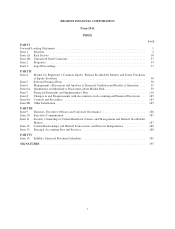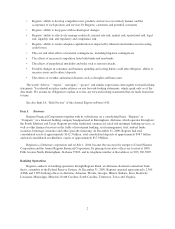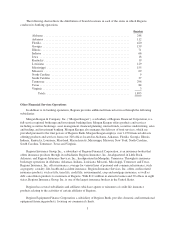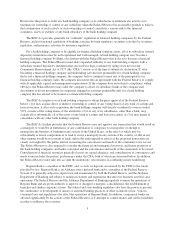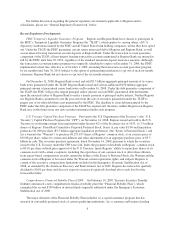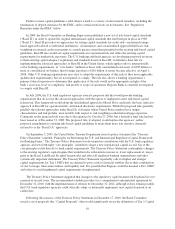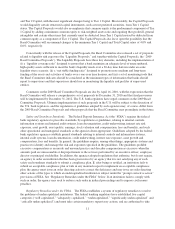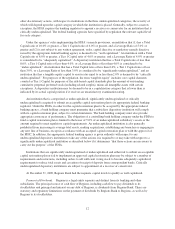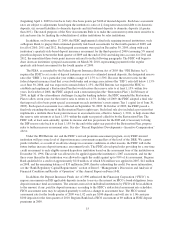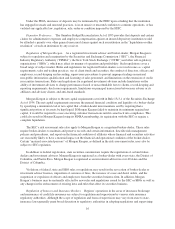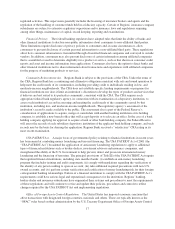Regions Bank 2009 Annual Report Download - page 22
Download and view the complete annual report
Please find page 22 of the 2009 Regions Bank annual report below. You can navigate through the pages in the report by either clicking on the pages listed below, or by using the keyword search tool below to find specific information within the annual report.Tier 1 FHC subsidiaries (whether regulated or unregulated) would be subject to consolidated supervision by the
Federal Reserve, although functionally regulated subsidiaries (such as banks and broker-dealers) would continue
to be supervised by their primary federal regulators.
Incentive Compensation. On October 22, 2009, the Federal Reserve issued a comprehensive proposal on
incentive compensation policies (the “Incentive Compensation Proposal”) intended to ensure that the incentive
compensation policies of banking organizations do not undermine the safety and soundness of such organizations
by encouraging excessive risk-taking. The Incentive Compensation Proposal, which covers all employees that
have the ability to materially affect the risk profile of an organization, either individually or as part of a group, is
based upon the key principles that a banking organization’s incentive compensation arrangements should
(i) provide incentives that do not encourage risk-taking beyond the organization’s ability to effectively identify
and manage risks, (ii) be compatible with effective internal controls and risk management, and (iii) be supported
by strong corporate governance, including active and effective oversight by the organization’s board of directors.
Any deficiencies in compensation practices that are identified may be incorporated into the organization’s
supervisory ratings, which can affect its ability to make acquisitions or perform other actions. The Incentive
Compensation Proposal provides that enforcement actions may be taken against a banking organization if its
incentive compensation arrangements or related risk-management control or governance processes pose a risk to
the organization’s safety and soundness and the organization is not taking prompt and effective measures to
correct the deficiencies. In addition, on January 12, 2010, the FDIC announced that it would seek public
comment on whether banks with compensation plans that encourage risky behavior should be charged higher
deposit assessment rates than such banks would otherwise be charged.
The scope and content of the U.S. banking regulators’ policies on executive compensation are continuing to
develop and are likely to continue evolving in the near future. It cannot be determined at this time whether
compliance with such policies will adversely affect the ability of Regions and its subsidiaries to hire, retain and
motivate their key employees.
Financial Crisis Responsibility Fees. On January 14, 2010, the current administration announced a
proposal to impose a fee (the “Financial Crisis Responsibility Fee”) on those financial institutions that benefited
from recent actions taken by the U.S. government to stabilize the financial system. If implemented as initially
proposed, the Financial Crisis Responsibility Fee will be applied to firms with over $50 billion in consolidated
assets, and, therefore, by its terms would apply to Regions. The Financial Crisis Responsibility Fee would be
collected by the Internal Revenue Service and would be approximately fifteen basis points, or 0.15%, of an
amount calculated by subtracting a covered institution’s Tier 1 capital and FDIC-assessed deposits (and/or an
adjustment for insurance liabilities covered by state guarantee funds) from such institution’s total assets.
The Financial Crisis Responsibility Fee, if implemented as proposed by the current administration, would go
into effect on June 30, 2010 and remain in place for at least ten years. The U.S. Treasury would be asked to
report after five years on the effectiveness of the Financial Crisis Responsibility Fee as well as its progress in
repaying projected losses to the U.S. government as a result of the TARP. If losses to the U.S. government as a
result of TARP have not been recouped after ten years, the Financial Crisis Responsibility Fee would remain in
place until such losses have been recovered.
General Regulatory Framework
Capital Adequacy. Regions and Regions Bank are required to comply with the applicable capital adequacy
standards established by the Federal Reserve. There are two basic measures of capital adequacy for bank holding
companies that have been promulgated by the Federal Reserve: a risk-based measure and a leverage measure.
The risk-based capital standards are designed to make regulatory capital requirements more sensitive to
differences in credit and market risk profiles among banks and financial holding companies, to account for
off-balance sheet exposure, and to minimize disincentives for holding liquid assets. Assets and off-balance sheet
8



